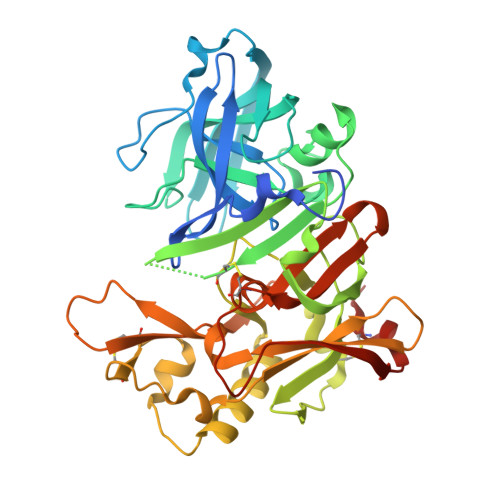Rational Design of Novel 1,3-Oxazine Based beta-Secretase (BACE1) Inhibitors: Incorporation of a Double Bond To Reduce P-gp Efflux Leading to Robust A beta Reduction in the Brain
Fuchino, K., Mitsuoka, Y., Masui, M., Kurose, N., Yoshida, S., Komano, K., Yamamoto, T., Ogawa, M., Unemura, C., Hosono, M., Ito, H., Sakaguchi, G., Ando, S., Ohnishi, S., Kido, Y., Fukushima, T., Miyajima, H., Hiroyama, S., Koyabu, K., Dhuyvetter, D., Borghys, H., Gijsen, H.J.M., Yamano, Y., Iso, Y., Kusakabe, K.I.(2018) J Med Chem 61: 5122-5137
- PubMed: 29733614
- DOI: https://doi.org/10.1021/acs.jmedchem.8b00002
- Primary Citation of Related Structures:
5YGY - PubMed Abstract:
Accumulation of Aβ peptides is a hallmark of Alzheimer's disease (AD) and is considered a causal factor in the pathogenesis of AD. β-Secretase (BACE1) is a key enzyme responsible for producing Aβ peptides, and thus agents that inhibit BACE1 should be beneficial for disease-modifying treatment of AD. Here we describe the discovery and optimization of novel oxazine-based BACE1 inhibitors by lowering amidine basicity with the incorporation of a double bond to improve brain penetration. Starting from a 1,3-dihydrooxazine lead 6 identified by a hit-to-lead SAR following HTS, we adopted a p K a lowering strategy to reduce the P-gp efflux and the high hERG potential leading to the discovery of 15 that produced significant Aβ reduction with long duration in pharmacodynamic models and exhibited wide safety margins in cardiovascular safety models. This compound improved the brain-to-plasma ratio relative to 6 by reducing P-gp recognition, which was demonstrated by a P-gp knockout mouse model.



















